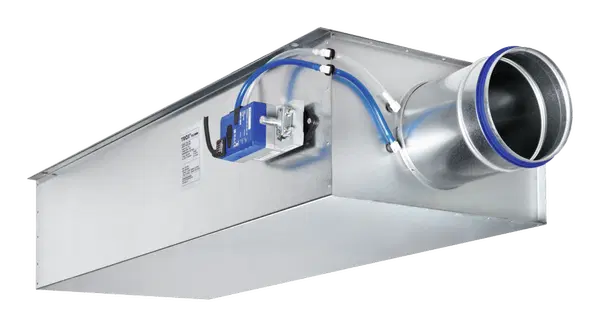

TVA

TVZ
July 4, 2022
TVRK
July 4, 2022TVA
FOR EXTRACT AIR SYSTEMS WITH DEMANDING ACOUSTIC REQUIREMENTS
VAV terminal units for extract air control in buildings with variable air volume systems and demanding acoustic requirements
- Highly effective integral attenuator
- Box style construction for the reduction of the airflow velocity
- Electronic control components for different applications (Easy, Compact, Universal, and LABCONTROL)
- Closed blade air leakage to EN 1751, up to class 4
- Casing air leakage to EN 1751, up to class C
Optional equipment and accessories
- Acoustic cladding for the reduction of case-radiated noise
- Secondary silencer Type TS for the reduction of air-regenerated noise
Description
Application
Application
- Rectangular VAV terminal units for use in ventilation and air conditioning systems
- For control, inductor and shut-off tasks in the extract air area with high acoustic requirements
- Integral attenuator
- Closed-loop volume flow control using an external power supply
- For variable or constant volume flow systems
- Shut-off via override control by others
- Can also be used for duct or room pressure control with suitable control components
Special features
- Integral attenuator with at least 26 dB insertion loss at 250 Hz
- Hygiene tested and certified
- Factory set-up or programming and aerodynamic function testing
- Setting and subsequent parameterisation on the control component possible, separate setting device may be required
Nominal sizes
125, 160, 200, 250, 315, 400
Variants
- TVA: Extract air unit
- TVA-D: Extract air unit with acoustic cladding
- Units with acoustic cladding and/or secondary silencer Type TS for very demanding acoustic requirements
- Acoustic cladding cannot be retrofitted
Parts and characteristics
- Ready-to-commission unit which consists of mechanical parts and control components
- Averaging effective pressure sensor for volume flow rate measurement
- Damper blade
- Integral attenuator
- Factory assembled control components complete with wiring and tubing
- Aerodynamic functional testing on a special test rig prior to shipping of each unit
- Set-up data is given on a label or volume flow rate scale affixed to the unit
- High control accuracy even in case of unfavourable upstream conditions
Attachments
- EASY controller: Compact unit consisting of controller with potentiometers, effective pressure transducer and actuator
- Compact controller: Compact unit consisting of controller with potentiometers, effective pressure transducer and actuator
- Universal controllers: Controllers, differential pressure transducers and actuators for special applications
- LABCONTROL: Control components for air management systems
Accessories
- Double lip seal (factory fitted)
Useful additions
- Secondary silencer Type TS
Construction features
- Rectangular casing
- Spigot on the fan end suitable for circular ducts to EN 1506 or EN 13180
- Spigot with groove for double lip seal
- Connection on the room end suitable for ducts
- Baffle plate is fitted after the damper blade for optimum aerodynamic performance
- Position of the damper blade indicated externally at shaft extension
- Thermal and acoustic insulation (lining)
Materials and surfaces
Casing and damper blade made of galvanised sheet steel
- Damper blade seal made of TPE plastic
- Lining is mineral wool
- Effective pressure sensor made of aluminium
- Plastic plain bearings
- Shaft and linkage made of galvanised steel
Variant with acoustic cladding (-D)
- Acoustic cladding made of galvanised sheet steel
- Lining is mineral wool
- Rubber elements for the insulation of structure-borne noise
Mineral wool
- To EN 13501, fire rating Class A1, non-combustible
- RAL quality mark RAL-GZ 388
- Non-hazardous to health thanks to being highly biosoluble in accordance with the Ordinance on Hazardous Substances and Note Q of the European Directive (EC) No. 1272/2008
- Faced with glass fibre fabric as protection against erosion through airflow velocities of up to 20 m/s
- Inert to fungal and bacterial growth
Standards and guidelines
Fulfils the hygiene requirements of
- EN 16798, Part 3
- VDI 6022, Sheet 1
- DIN 1946, Part 4
- Further standards, guidelines in accordance with hygiene certificate
Casing leakage: NS 125 – 200
- EN 1751, Class C
NS 250 – 400
- EN 1751, Class B
Closed blade air leakage:
- EN 1751, Class 4
- Meets the increased requirements of DIN 1946, Part 4, with regard to the acceptable closed damper blade air leakage
Maintenance
- Maintenance-free as construction and materials are not subject to wear
Download
Product Information
Certificates
Operation Manuals






